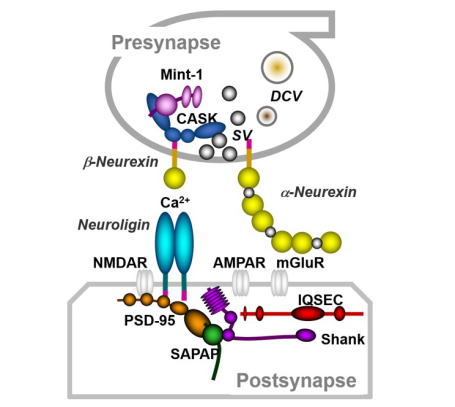Department of Molecular & Cellular Physiology is focusing on the relevance between synaptic defect and the pathophysiology of neurodevelopmental disorders, such as autism.
RESEARCH STATEMENT
Synapses are sites that connect neurons each other to extend networks in the human brains and transmit signals required for cognition and thought in daily activities. We intend to uncover mechanisms by which brains function, by studying molecules act at synapses. We also aim to uncover the pathophysiology of neuropsychiatric disorders caused by dysfunctions of these molecules.
1. Neurexin/Neuroligin and neurodevelopmental disorders
 Neurexins and Neuroligins are families of synaptic cell adhesion molecules
localized at pre- and postsynapses, respectively. Neurexins and Neuroligins
bind in the presence of calcium at the synaptic cleft, triggering synapse
formation and maturation. Over the past two decades, genetic abnormalities
in Neurexins and Neuroligins have been repeatedly discovered in patients
with neurodevelopmental disorders, such as autism, leading to the hypothesis
that disruptions in synaptic function maintained by Neurexin/Neuroligin
may be related to the pathogenesis of these disorders. Our laboratory investigates
genetically modified mice for Neurexins and Neuroligins, focusing on their
synaptic functions using biochemical, pharmacological, electrophysiological,
and morphological methods. We also study their disease-related behaviors
to explore the causal relationship with these disorders.
Neurexins and Neuroligins are families of synaptic cell adhesion molecules
localized at pre- and postsynapses, respectively. Neurexins and Neuroligins
bind in the presence of calcium at the synaptic cleft, triggering synapse
formation and maturation. Over the past two decades, genetic abnormalities
in Neurexins and Neuroligins have been repeatedly discovered in patients
with neurodevelopmental disorders, such as autism, leading to the hypothesis
that disruptions in synaptic function maintained by Neurexin/Neuroligin
may be related to the pathogenesis of these disorders. Our laboratory investigates
genetically modified mice for Neurexins and Neuroligins, focusing on their
synaptic functions using biochemical, pharmacological, electrophysiological,
and morphological methods. We also study their disease-related behaviors
to explore the causal relationship with these disorders.
LINK
Autism Spectrum Disorder (ASD)
2. CASK and disorders
CASK is a synaptic scaffold protein belonging to the MAGUK (Membrane Associated
Guanylate Kinase) family, originally identified as an intracellular binding
partner for Neurexins. Numerous genetic abnormalities in CASK have also
been found in patients with neurodevelopmental disorders, such as autism,
epilepsy, and intellectual disabilities, suggesting a connection between
these conditions. Recently, CASK was identified as the causative gene for
MICPCH (Microcephaly with Pontine and Cerebellar Hypoplasia) syndrome.
The CASK gene is located on the X chromosome, and males with complete loss
of CASK are not viable; thus, most MICPCH syndrome patients are female.
Patients with MICPCH syndrome exhibit cerebellar hypoplasia along with
a wide range of neurodevelopmental disorder symptoms. Our laboratory studies
CASK knockout mice as disease models for CASK-related disorders.
3. Postsynaptic protein IQSEC2 and disorders
IQSEC2 is a synaptic guanine nucleotide exchange factor (GEF) for ADP-ribosylation factor (Arf6), which localizes at postsynapses. It regulates synaptic function by responding to calcium influx at the postsynaptic membrane, activating Arf6, and modulating AMPA receptor trafficking at the excitatory postsynaptic site. Genetic abnormalities in IQSEC2 have also been discovered in patients with autism, intellectual disabilities, and epilepsy, suggesting a link with neurodevelopmental disorders. Our laboratory studies IQSEC2 knockout mice as disease models for these disorders.
banner
Department of Molecular &
Cellular Physiology,
Shinshu University School of Medicine
3-1-1 Asahi, Matsumoto,
Nagano 390-8621
Japan
PHONE: +81-263-37-3775
FAX: +81-263-37-3776
E-mail: ktabuchi@shinshu-u.ac.jp